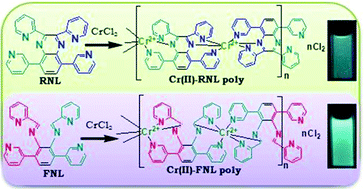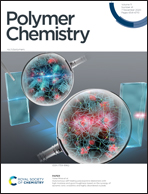Syntheses, characterization, multi-acid fluorescence sensing and electroluminescence properties of Cr(ii)-based metallopolymers†
Abstract
Two novel Cr(II) based metallosupramolecular polymers have been synthesized with two ditopic rigid and flexible ligands in identical reaction conditions. Confirmation of the structure of both the polymers and the different properties of them were thoroughly studied using NMR, attenuated total reflectance infra-red spectra (ATR-IR), and other spectroscopic and morphological techniques, along with thermal, and electrochemical analysis to understand the structure–property relationship. The field emission scanning electron microscopy (FESEM) and atomic force microscopy (AFM) micrographs of the rigid and flexible polymers revealed an entirely different morphology for these two because of the inherent difference in the backbone rigidity. Both the metallopolymers worked as multi-acid sensors as their fluorescent properties varied in the presence of different acids. Reversible electroluminescent ON–OFF switching has been found in these polymers upon application of the appropriate potentials.



 Please wait while we load your content...
Please wait while we load your content...